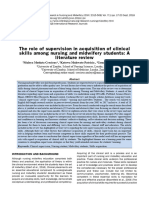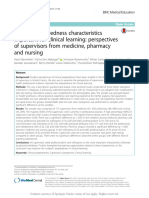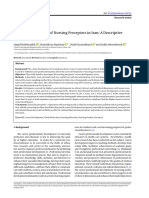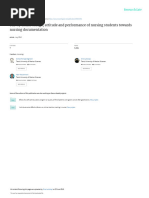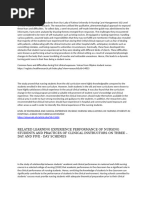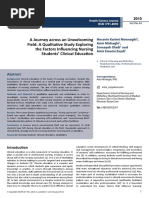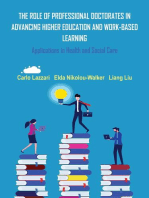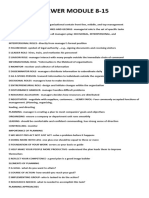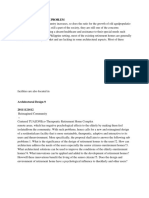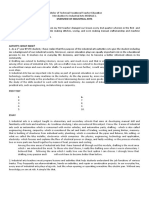The Relationship Between Clinical Competence and Clinical Self-Efficacy Among Nursing and Midwifery Students
The Relationship Between Clinical Competence and Clinical Self-Efficacy Among Nursing and Midwifery Students
Uploaded by
issaiahnicolleCopyright:
Available Formats
The Relationship Between Clinical Competence and Clinical Self-Efficacy Among Nursing and Midwifery Students
The Relationship Between Clinical Competence and Clinical Self-Efficacy Among Nursing and Midwifery Students
Uploaded by
issaiahnicolleOriginal Title
Copyright
Available Formats
Share this document
Did you find this document useful?
Is this content inappropriate?
Copyright:
Available Formats
The Relationship Between Clinical Competence and Clinical Self-Efficacy Among Nursing and Midwifery Students
The Relationship Between Clinical Competence and Clinical Self-Efficacy Among Nursing and Midwifery Students
Uploaded by
issaiahnicolleCopyright:
Available Formats
See discussions, stats, and author profiles for this publication at: https://www.researchgate.
net/publication/305589776
The Relationship between Clinical Competence and Clinical Self- efficacy
among Nursing and Midwifery Students
Article in International Journal of Pediatrics · December 2015
DOI: 10.22038/ijp.2015.5222
CITATIONS READS
7 278
4 authors, including:
Shahla Mohamadirizi Shahnaz Kohan
Isfahan University of Medical Sciences Isfahan University of Medical Sciences
17 PUBLICATIONS 61 CITATIONS 87 PUBLICATIONS 284 CITATIONS
SEE PROFILE SEE PROFILE
Soheila Mohamadirizi
Isfahan University of Medical Sciences
39 PUBLICATIONS 201 CITATIONS
SEE PROFILE
Some of the authors of this publication are also working on these related projects:
Reproductive and sexual health View project
The process of midwifery students' socialization View project
All content following this page was uploaded by Shahnaz Kohan on 24 July 2016.
The user has requested enhancement of the downloaded file.
http:// ijp.mums.ac.ir
Original Article (Pages: 1117-1123)
The Relationship between Clinical Competence and Clinical Self-
efficacy among Nursing and Midwifery Students
Shahla Mohamadirizi1, Shahnaz Kohan 2, Fatemeh Shafei3, *Soheila Mohamadirizi41
1
Department of Nursing, School of Nursing and Midwifery, Isfahan University of Medical Sciences, Isfahan,
Iran.
2
Department of Midwifery, Women Health Research Center, Isfahan University of Medical Sciences, Isfahan,
Iran.
3
Nursing and Midwifery School, Isfahan University of Medical Sciences, Isfahan, Iran.
4
Department of Midwifery, Women Health Research Center, School of Nursing and Midwifery, Isfahan
University of Medical Sciences, Isfahan, Iran.
Abstract
Introduction
Self-efficacy in clinical performance had an important role in applying competencies; also
competencies and self-efficacy in clinical performance influenced to quality care of nursing and
midwifery students. So the present study aimed to define the relationship between clinical
competencies and clinical self-efficacy among nursing and midwifery students.
Materials and Methods
This is a cross-sectional study conducted on 150 of nursing and midwifery students in Isfahan
University of Medical Science, selected through two stage sampling in 2014. The participant
completed questionnaires about personal/ educational characteristics and nursing competencies
questionnaire (18 items) and clinical self-efficacy scale (37 items). The data were analyzed by,
Pearson statistical test, t-test, variance analysis through SPSS version16.
Results
The results showed that 50% (n=75) and 37.4% (n=56) of nursing and midwifery students had good
clinical competence and clinical Self-Efficacy, respectively. Also the mean competencies and self-
efficacy in clinical performance scores were 35.05± 1.2 and 76.03± 0.4 respectively. Pearson
correlation coefficient showed that there was a positive linear correlation between the score of clinical
competence and clinical self-efficacy (P<0.05, r=0.73).
Conclusion
The results reveal that self-efficacy is a significant predictor of a student's clinical performance
therefore increasing clinical competence related to high clinical Self-efficacy.
Key Words: Clinical competence, Clinical performance, Self-efficacy, Students.
*Corresponding Author:
Soheila Mohamadirizi, School of Nursing and Midwifery, Isfahan University of Medical Sciences, Isfahan, Iran.
Email: mohamadirizi@nm.mui.ac.ir
Received date: Aug 5, 2015 Accepted date: Aug 22, 2015
Int J Pediatr, Vol.3, N.6-2, Serial No.24, Dec 2015 1117
Relationship between Self-efficacy and Clinical Competencies in Students
Introduction the competencies in order to be effective in
their clinical performance (8). In this
Clinical competence is defined as the
regard, Parsa Yekta conducted a study to
ability to solve complex problems using a
determine the clinical competence of 91
combination of knowledge, attitude and
nursing students. He showed that most
practical skills and its goal is to assess the
studied students had moderate clinical
practical capabilities of medical students in
competence (8). Whereas, Hakimzadeh’s
various fields in order to meet the needs of
study revealed that generally students have
public service (1). The undesirable
rated their clinical competence slightly
practical skills of medical students may be
above average (3). About acquisition of
due this reason that in most performance-
clinical competence in nursing and
based tests, basic and theoretical skills are
midwifery students, understanding the
ignored and not assessed and their success
influencing factors in its development is
on tests greatly depends on subjective
important (9). Furthermore, there are
memories and conceptions and in
appropriate solutions to predict students’
performance-based tests at the end of the
clinical skills that one of which is paying
course, a part of the score is for the
attention to students’ self-efficacy beliefs
diagnosis and treatment and consequences
for clinical skills evaluation. In fact, it
of the treatment (2, 3).
seems that obtaining multilateral
In fact, clinical competence is the ultimate information from intelligence capabilities
goal of nursing education and includes the and competencies of students can enrich
ability to apply professional knowledge the clinical evaluation. One of the most
and skills, communication and important information is the student’s
interpersonal skills, and advanced problem personal belief and understanding his own
solving and decision making skills (4). “effectiveness”. This variable can be a
According to the above-mentioned, reliable predictor of student’s clinical
competence in nursing and midwifery will competence and skills (10). Accordingly,
be considered as the ability to perform students’ evaluation of their own
nursing duties, and the ability to effectiveness is an appropriate guideline to
effectively integrate the cognitive, predict their clinical skills, because there is
affective and psychomotor skills while a significant positive relationship between
performing patient care (5). Assessment of the self-efficacy and performance of the
clinical competence, particularly in students (11, 12). In fact, the self-efficacy
identifying areas that need improvement as is one of the contributing factors that not
well as determining the educational needs only can affect the performance and
of nurses, is of great importance. So that is clinical competence of people working in
considered as the most important the healthcare field, but also can affect
responsibility of managers in clinical medical and paramedical students (13).
settings (6). In our country, recently, due Self-efficacy also mediates between the
to the increased community awareness and knowledge and behavior and is associated
expectations about receiving high-quality with professional competence (14). Rice’s
services, paying attention to the clinical study (2013) showed that there was no
competence of nurses and midwives has correlation between clinical competence
become more important (7). According to and self-clinical of students (15); whereas,
the Australian Nursing Association, the studies by Hasani and the Haqqani
nursing students should have sufficient (2013) and Yu (2006) showed that there
self-awareness about their professional was a significant correlation between these
qualifications when graduating and also two variables (13, 16, 17).
their attitudes should be positive toward
Int J Pediatr, Vol.3, N.6-2, Serial No.24, Dec 2015 1118
Mohamadrizi et al.
Given the above, obtaining clinical a medical history, I am able to establish a
competency is one of the important goals relation between separated information of
of medical education and its evaluation is the patient). This questionnaire has 5
also of utmost importance. Today, efforts separate areas including examining the
are made to adopt new approaches to patient, nursing diagnosis, planning care
assess and evaluate the capabilities of program, implementing care program, and
students of Medical Sciences in order to evaluation of care program. The overall
promote the quality of this part of score of this questionnaire is from 0 to 102
educational process (5, 6). (poor 0-37, medium 38-74, and good 75-
102). This questionnaire has been used in
In the present study, by introducing the
studies in Iran, including Cheraqi and the
concept of clinical self-efficacy in the field
Haqqani (2013) and its content validity
of clinical competency evaluation,
and reliability (Cronbach's alpha 0.92) has
appropriate complementary to assess and
been approved by the Haqqani’s study
judge on medical students’ clinical
(2013) (14, 16). The third part of the
capability is presented (8, 18). Given that
questionnaire is a shortened questionnaire
more than 80% of direct patient care is
of “clinical competence” which consists of
carried out by nurses and midwives (11,
18 items (for example: I try to provide
19) and also according to the few studies
standard care, I have a unique approach in
that have been conducted regarding the
planning patient care, when the patient
objective of the study and the
asks a question I show my logical thoughts
contradictory results (13, 15-17), this study
and behaviors), and is based on a 4 point
aimed to determine the relationship
Likert scale rated from 1 (completely true)
between clinical self-efficacy and clinical
to 4 (wrong).
competence in nursing and midwifery
students in Isfahan city, the center of Iran, To prove the face and content validity, the
in 2014. third part of the questionnaire was
translated and the necessary changes was
Materials and Methods made, then it was delivered to five experts
At a cross-sectional study, stratified in the field along with the English version
sampling method was applied for this to be revised. After proposed amendments
study. Then, in proportional to the number of the experts were applied, the tools were
of senior students in each field and based given to three professors for final
on the number of students, 100 nursing reviewing and approval. For determining
students and 50 midwifery students were the reliability of both questionnaires, test-
randomly selected. retest method was used (on ten students at
The researcher made questionnaire the beginning of the study), and it was
consists of three parts: the first part approved with a correlation coefficient of
includes reviewing the educational 0.96.
demographic characteristics (age, gender, To do the study, the researcher referred to
education level, field of Study, marital the place of students’ apprenticeship in
status); the second part of the each of the disciplines of nursing and
questionnaire is about “clinical self- midwifery and after explaining the purpose
efficacy” which contains 37 items based of the study and how to complete the
on a 4 point Likert scale rated from quite questionnaire, the researcher attempted to
always (0) to never (3) (for example, I am do sampling and carry out the research.
able to gather the necessary information After obtaining informed consent form
through physical examination, I am able to students, a three-part questionnaire that
gather the necessary information by taking included demographic/academic
Int J Pediatr, Vol.3, N.6-2, Serial No.24, Dec 2015 1119
Relationship between Self-efficacy and Clinical Competencies in Students
characteristics, clinical self-efficacy scale 23 ± 1.4 years. Also, 88 subjects (59%)
and clinical skills questionnaire was were single and 62 subjects (41%) were
completed by participants. The data were married.
analyzed by SPSS version 16, also P<0.05 Frequency distribution of subjects’ based
was considered as significant level. on clinical competence and clinical self-
Results efficacy level in (Table.1) and dimensions
of clinical self-efficacy are shown in
A total of 150 students participating,
(Table.2).
92 subjects (61.4%) were women and 58
subjects (38.6%). Subjects’ mean age was
Table 1: Frequency distribution of subjects’ based on clinical competence and clinical self-efficacy
levels
Variables N %
Clinical competence
Well (63-72) 75 50.5
Moderate (51-62) 72 48.4
Poor (34-50) 3 1.1
Total 150 100
Clinical self-efficacy
Well (92-111) 56 37.4
Moderate (71-91) 80 53.3
Poor (37-90) 14 9.3
Total 150 100
Table 2: Frequency distribution of subjects’ based on 5 dimension of clinical self-efficacy
5 Dimension of clinical self-efficacy SD ± Mean
Patient Survey 4.1±17.99
Nursing Diagnosis 3.4±17.25
Care Program Planning 4.4±17.1
Care Program Performing 3.4±13.97
Care Program Evaluating 3.7±14.82
Pearson correlation index showed a correlation between 5 dimension of
positive correlation between scores of clinical self-efficacy and clinical
clinical competence and clinical self- competence.
efficacy in a way that an increase in score In order to control confounding factors, all
of clinical competence increases score of quantitative variables were entered into
clinical self-efficacy (P=0.001, r=0.73). linear regression model through concurrent
Based on Pearson correlation index entrance method (Table 4).
(Table.3) showed that there was a positive
Int J Pediatr, Vol.3, N.6-2, Serial No.24, Dec 2015 1120
Mohamadrizi et al.
Table 3: Correlation between 5 dimension of clinical self-efficacy and clinical competence
5 Dimension of clinical self-efficacy P value Pearson’s correlation
coefficient
Patient Survey 0.006 0.45
Nursing Diagnosis 0.004 0.62
Care Program Planning 0.023 0.28
Care Program Performing 0.012 0.81
Care Program Evaluating 0.033 0.42
Table 4: Linear regression between predictor variables and dependent variables
Coefficient a
Predictor variables Standardized Coefficients Unstandardized P value
Coefficients
Beta Std. Error Beta
Clinical competence .091 .031 .133 .011
score
Age .089 .066 .031 .076
Courses .224 .086 .138 .609
a Dependent variable: Total clinical self-efficacy SCORE
Discussion In another study it is also stated that,
according to the participants, self-efficacy
The main results of the present study
along with clinical competence give the
showed that there was a significant
nurses a sense of self-sufficient. Sense of
positive correlation (r = 0.73) between
self-sufficient, in turn, makes them
total score of clinical competence of
creative in helping the patients and the
students and clinical efficacy as well as its
nurses can take more efficient decisions
five areas, so that with an increase in
(20). The study by Rice showed that there
clinical self-efficacy, students had more
was no correlation between clinical self-
clinical competence. In line with the
efficacy and the nursing students’ clinical
results of present study, the findings of the
competencies (15). Different educational
study by Hasani in Tehran showed that
environments and also different
nursing students during the field training
environments of educational hospitals and
believe that self-efficacy in clinical
also differences in the culture of each
performance is synonymous with obtaining
society and even each city, and the
clinical competency and providing proper
difference in the number of passed
care for the patient. These two are based
semesters (final-year students in the
on knowledge and experience within the
present study versus students in their sixth
framework of evaluating the patients,
semester and higher in Rice’s study) are
planning, implementation, and evaluating
some of the reasons for the difference and
nursing care (13).
inconsistency of the studies. One limitation
Int J Pediatr, Vol.3, N.6-2, Serial No.24, Dec 2015 1121
Relationship between Self-efficacy and Clinical Competencies in Students
of this study is that evaluating clinical results of present study can be used for
competence by using self-assessment educational planning of midwifery and
method can reduce the accuracy and nursing, implementing new training
objectivity of this evaluation method methods, and clinical evaluation by the
because the subjects may give themselves heads of departments and as a result they
unrealistic scores, that is why this method pay more attentions to the students’
of assessment of clinical competence performance in clinical settings.
should be evaluated as a part of an Furthermore, the results of this study can
approach, not all of it. Although the be used by nursing students for self-
researcher is aware of these limitations, he assessment of clinical performance.
believes that trusting in nursing and Feedback related to the results of the study
midwifery students can motivate them to will help the students to gain self-
think and take decisions about how to awareness and self-confidence about their
provide care; furthermore, it enables them professional capabilities. Also, based on
to fulfill their responsibilities in clinical their level of self-efficacy, they can assess
performance. However, given the their educational needs, develop strategies
foregoing discussion, it can be suggested for clinical learning, and monitor and
that for future studies researchers can use evaluate their own learning.
other methods to assess the clinical
competence, such as assessment of Acknowledgments
students by trainers and officials of the This study is part of a proposal,
wards with direct observation and approved 2014 with code 293215, Isfahan
evaluation of care outcomes. The other University of Medical Science, Iran which
limitation of this study that should be is sponsored with research deputy. Also,
noted is that the students did not hope that we greatly appreciate the support and
the results of the study would be used in cooperation of this Vice Chancellery, as
decision making related to their well as all nursing and midwifery students.
performance in clinical settings; therefore,
they did not show great interest in Conflict of Interest: None.
completing the questionnaires which, in
turn, may affect the accuracy of the References
findings. Due to cross-sectional nature of 1. Wu EH, Elnicki DM, Alper EJ, Bost JE,
evaluation in this study, the findings are Corbett EC Jr, Fagan MJ, et al. Procedural and
less generalizable to the decisive policies. interpretive skills of medical students:
Therefore, it is recommended that a experiences and attitudes of thirdyear students.
continuous and institutionalized evaluation Academic Medicine 2006;81(10):48-51.
be done annually, so as to help for the 2. Jacobs JC, Denessen E, Postma CT. The
recovery of the course. structure of medical competence and results of
an OSCE. The Netherlands journal of
Conclusion Medicine 2004; 62(10):397-403
The results of this study support the 3.Ghanadi K, Anbari K, Zendedel A. Clinical
hypothesis that there is a correlation Competency. Strides Dev Med Educ 2013; 10
between the “clinical self-efficacy” and (3) : 398-400.
“clinical competence” of senior students of 4. Hakimzadeh R, Karamdost N, Memarian R,
nursing and midwifery. Therefore, clinical Ghodrati A , Mirmosavi J. Assessing nursing
self-efficacy will result in a more accurate students’ clinical competency: self-assessment.
assessment of clinical competence of Nursing Vision 2012; 1(1): 20-5.
nursing and midwifery students. The
Int J Pediatr, Vol.3, N.6-2, Serial No.24, Dec 2015 1122
Mohamadrizi et al.
5. Reid F. Baccalaureate education and 13. Hassani P, Cheraghi F, Yaghmaei F. Self-
professional practice. Nurse Outlook 2000; efficacy and Self-regulated Learning in
15(3):50-9. Clinical Performance of Nursing Students: A
Qualitative Research. Iranian Journal of
6. Bahreini M, Moattari M, Kaveh M, Ahmadi
Medical Education 2008; 8(1): 33-41.
F. A Comparison of Nurses' Clinical
Competences in Two Hospitals Affiliated to 14. Cheraghi F, Hassani P,Yaghmaei F, Alavi-
Shiraz and Boushehr Universities of Medical Majed H. Developing a valid and reliable self-
Sciences: A Self-Assessment. Iranian Journal efficacy in clinical performance scale.
of Medical Education 2010; 10(2): 101-9. International Council of Nurses
2009;56(2):214-21.
7. Bagheri Nesami M, Rafiee F, Parvizi S,
Esmaeili R. Concept analysis of competency in 15. Rice EW. The relationship between emotional
nursing: Qualitative research and delivery of a intelligence, selfefficacy, and clinical
Hybrid model. J mazandaran Univ Med Sci performance in associate degree Nursing
2007; 18(67):35-42. students (Dissertation). Northeastern United
States: Capella University; 2013.
8. Parsa-Yekta Z, Ramezani Badr F, Khaton A.
Nursing students' viewpoints about their 16. Haghani F, Asgari F, Zare S, Mahjoub Mh.
clinical competencies and its achievement Correlation between self-efficacy and clinical
level. Iranian Journal of Nursing Research performance of the internship nursing students
2007(3):7-14. 2013; 5(1):23-31.
9. Memarian R, Salsali M, Vanaki Z, Ahmadi F, 17. Yoo, MS, Son, YJ, Yoo, IY, et al.
Hajizadeh E. Factors Affecting the Process of Relationship between Self-Efficacy and
Obtaining Clinical Competency. ZUMS Clinical Skill Competence of Nursing
Journal 2006; 14 (56) :40-9. Students. Journal of Korean Academy of
Fundamentals of Nursing 2006 13(3):343-50.
10. Hassankhani H, Mohajjel Aghdam A,
Rahmani A, Mohammadpoorfard Z. Assessing 18. Ghourchaie A, Hadjabadi MR. Medical
Self-efficacy in Clinical Competence Among students' viewpoints of their goal achievement
Nursing Students at Tabriz University of in ENT clerkship period in Birjand University
Medical Sciences. Zeynab Jundishapur Sci of Medical Sciences. The Journal of Qazvin
Med J 2015;6(2):108-14. University of Medical Sciences & Health
Services 2004; 30: 19-23.
11. Chehrzad MM, Shafiei Pour SZ, Mirzaei M,
Kazem Nejad E. Comparison between two 19. Kordi M, Mohamadirizi S, Shakeri MT. The
methods: Objective Structured Clinical relationship between occupational stress and
Evaluation (OSCE) and traditional on nursing dysmenorrhea in midwives employed at public
students' satisfaction. Journal of Medical and private hospitals and health care centers in
Faculty Guilan of Medical Science 2004; Iran (Mashhad) in the years 2010 and 2011.
13(50):8-13. Iranian Journal of Nursing and Midwifery
Research 2013; 18(4): 316-22.
12. Mohammadi F, Hosseini MA. Rehabilitation
Sciences Students' Perception from Clinical 20. Hajbaghery MA, Salsali M, Ahmadi F. The
Self-Efficacy Compared to Evaluation by factors facilitating effective clinical decision-
Clinical Teachers. Iranian Journal of Medical making in nursing: a qualitative study. BMC
Education 2010;10(2):155-63. Nurs 2004;3(1):2.
Int J Pediatr, Vol.3, N.6-2, Serial No.24, Dec 2015 1123
View publication stats
You might also like
- LEVEL 2-Anxiety-Adult (PROMIS Emotional Distress-Anxiety - Short Form)No ratings yetLEVEL 2-Anxiety-Adult (PROMIS Emotional Distress-Anxiety - Short Form)1 page
- Exploring The Challenges of Clinical EducationNo ratings yetExploring The Challenges of Clinical Education8 pages
- Sources of Stress and Coping Behaviors Among Nursing Students Throughout Their First Clinical TrainingNo ratings yetSources of Stress and Coping Behaviors Among Nursing Students Throughout Their First Clinical Training7 pages
- The Role of Supervision in Acquisition of Clinical Skills Among Nursing and Midwifery Students A Literature ReviewNo ratings yetThe Role of Supervision in Acquisition of Clinical Skills Among Nursing and Midwifery Students A Literature Review7 pages
- The Challenges of Nursing Students in The Clinical Learning EnvironmentNo ratings yetThe Challenges of Nursing Students in The Clinical Learning Environment20 pages
- Student Preparedness Characteristics Important ForNo ratings yetStudent Preparedness Characteristics Important For10 pages
- Gap Between Theory and Practice in The NursingNo ratings yetGap Between Theory and Practice in The Nursing7 pages
- Career Development of Nursing Preceptors in Iran A Descriptive StudyNo ratings yetCareer Development of Nursing Preceptors in Iran A Descriptive Study5 pages
- JMRH - Volume 3 - Issue 1 - Pages 262-268No ratings yetJMRH - Volume 3 - Issue 1 - Pages 262-2687 pages
- Related Learning Experience Performance of Nursing Students and Practices of Clinical Instructors On Three - Day and Five - Day SchemesNo ratings yetRelated Learning Experience Performance of Nursing Students and Practices of Clinical Instructors On Three - Day and Five - Day Schemes2 pages
- Interprofessional Teamwork Skills As Predictors of Clinical Outcomes in A Simulated Healthcare SettingNo ratings yetInterprofessional Teamwork Skills As Predictors of Clinical Outcomes in A Simulated Healthcare Setting6 pages
- Hubungan Pengetahuan Terhadap Kompetensi Mahasiwa Profesi Ners Dalam Penerapan Evidence Based PracticeNo ratings yetHubungan Pengetahuan Terhadap Kompetensi Mahasiwa Profesi Ners Dalam Penerapan Evidence Based Practice6 pages
- Research Article: The Challenges of Nursing Students in The Clinical Learning Environment: A Qualitative StudyNo ratings yetResearch Article: The Challenges of Nursing Students in The Clinical Learning Environment: A Qualitative Study8 pages
- Research Article: The Challenges of Nursing Students in The Clinical Learning Environment: A Qualitative StudyNo ratings yetResearch Article: The Challenges of Nursing Students in The Clinical Learning Environment: A Qualitative Study8 pages
- Self-Efficacy and Clinical Competence of Fourth-Year Nursing Students: A Self-Reported StudyNo ratings yetSelf-Efficacy and Clinical Competence of Fourth-Year Nursing Students: A Self-Reported Study7 pages
- Psychometric_properties_of_the_persian_version_of_No ratings yetPsychometric_properties_of_the_persian_version_of_8 pages
- Chapter 1 Leanne-Rah Inding Bsn3-A - 095557No ratings yetChapter 1 Leanne-Rah Inding Bsn3-A - 0955578 pages
- Identifikasi Tantangan Ke Babak Klinis Yang Baik Studi Kelompok Terarah Guru MedisNo ratings yetIdentifikasi Tantangan Ke Babak Klinis Yang Baik Studi Kelompok Terarah Guru Medis12 pages
- Clinical Evaluation of Baccalaureate Nursing Students Using SBAR Format: Faculty Versus Self EvaluationNo ratings yetClinical Evaluation of Baccalaureate Nursing Students Using SBAR Format: Faculty Versus Self Evaluation5 pages
- The Impact of Role Models On Medical Students: Scott Wright, MD, Annie Wong, MD, Carol Newill, MD, PHDNo ratings yetThe Impact of Role Models On Medical Students: Scott Wright, MD, Annie Wong, MD, Carol Newill, MD, PHD4 pages
- The Scientific World Journal - 2016 - Jamshidi - The Challenges of Nursing Students in the Clinical Learning Environment ANo ratings yetThe Scientific World Journal - 2016 - Jamshidi - The Challenges of Nursing Students in the Clinical Learning Environment A7 pages
- A Journey Across An Unwelcoming Field A Qualitative Study Exploring The Factors Influencing Nursing Students Clinical EducationNo ratings yetA Journey Across An Unwelcoming Field A Qualitative Study Exploring The Factors Influencing Nursing Students Clinical Education6 pages
- Professional Values of Nurses and Nursing Students: A Comparative StudyNo ratings yetProfessional Values of Nurses and Nursing Students: A Comparative Study7 pages
- Barriers To Clinical Education From The Perspective of Nursing Students in Iran An Integrative RevNo ratings yetBarriers To Clinical Education From The Perspective of Nursing Students in Iran An Integrative Rev7 pages
- Evaluation of Internship Assessment in Medical ColNo ratings yetEvaluation of Internship Assessment in Medical Col5 pages
- Bedside Learning: Vital For Nursing Education - Creating Competent, Empathetic Healthcare ProfessionalNo ratings yetBedside Learning: Vital For Nursing Education - Creating Competent, Empathetic Healthcare Professional5 pages
- Wong et Kowitlawakul - 2020 - Exploring perceptions and barriers in developing cNo ratings yetWong et Kowitlawakul - 2020 - Exploring perceptions and barriers in developing c6 pages
- Undergraduate Ipe Education Using High FidelityNo ratings yetUndergraduate Ipe Education Using High Fidelity8 pages
- Iranian Staff Nurses' Attitudes Toward Nursing Students: Nurse Education Today October 2010No ratings yetIranian Staff Nurses' Attitudes Toward Nursing Students: Nurse Education Today October 20106 pages
- The Question of Competence: Reconsidering Medical Education in the Twenty-First CenturyFrom EverandThe Question of Competence: Reconsidering Medical Education in the Twenty-First CenturyNo ratings yet
- A Guide to Medical Teaching and Learning Training of the Trainers (Tot): In the View of the Learner-Centered Learning ModelFrom EverandA Guide to Medical Teaching and Learning Training of the Trainers (Tot): In the View of the Learner-Centered Learning ModelNo ratings yet
- Clinical Research Associate - The Comprehensive Guide: Vanguard ProfessionalsFrom EverandClinical Research Associate - The Comprehensive Guide: Vanguard ProfessionalsNo ratings yet
- THE ROLE OF PROFESSIONAL DOCTORATES IN ADVANCING HIGHER EDUCATION AND WORK-BASED LEARNING: Applications in Health and Social CareFrom EverandTHE ROLE OF PROFESSIONAL DOCTORATES IN ADVANCING HIGHER EDUCATION AND WORK-BASED LEARNING: Applications in Health and Social CareNo ratings yet
- Pamantasan NG Cabuyao: College of NursingNo ratings yetPamantasan NG Cabuyao: College of Nursing78 pages
- This Study Resource Was: Patient InformationNo ratings yetThis Study Resource Was: Patient Information1 page
- This Study Resource Was Shared Via: Nursing Care Plan FormNo ratings yetThis Study Resource Was Shared Via: Nursing Care Plan Form3 pages
- Arteriovenous Shunt or Arteriovenous (Bridge) FistulaNo ratings yetArteriovenous Shunt or Arteriovenous (Bridge) Fistula1 page
- Pamantasan NG Cabuyao Banay-Banay, Cabuyao City, Laguna Bachelor of Science in Nursing Diagnostic Examination Iii-A100% (2)Pamantasan NG Cabuyao Banay-Banay, Cabuyao City, Laguna Bachelor of Science in Nursing Diagnostic Examination Iii-A19 pages
- Description: Single-Photon Emission Computed TomographyNo ratings yetDescription: Single-Photon Emission Computed Tomography2 pages
- Application of Eye Patch, Eye Shield and Pressure Dressing To The EyeNo ratings yetApplication of Eye Patch, Eye Shield and Pressure Dressing To The Eye2 pages
- NCP - Left Superior Homonymous QuadrantanopiaNo ratings yetNCP - Left Superior Homonymous Quadrantanopia19 pages
- Insights Into One'S Personal Development: Week 5No ratings yetInsights Into One'S Personal Development: Week 55 pages
- 140.usa Basketball Youth Basketball GuidelinesNo ratings yet140.usa Basketball Youth Basketball Guidelines11 pages
- The Crisis of Certainties at The Beginning of The 20th Century - With Revisions100% (1)The Crisis of Certainties at The Beginning of The 20th Century - With Revisions2 pages
- How To Use Your Numerology Reading in Your Current CareerNo ratings yetHow To Use Your Numerology Reading in Your Current Career2 pages
- (FREE PDF Sample) Clinical Assessment Workbook: Balancing Strengths and Differential Diagnosis 2nd Edition - Ebook PDF Version Ebooks100% (30)(FREE PDF Sample) Clinical Assessment Workbook: Balancing Strengths and Differential Diagnosis 2nd Edition - Ebook PDF Version Ebooks49 pages
- Chapt 4 Ethics Training Program in An OrganizationNo ratings yetChapt 4 Ethics Training Program in An Organization26 pages
- heideggerian-existential-therapy-1nbsped-9781032378275-9781032378251-9781003342137-1032378271_compressNo ratings yetheideggerian-existential-therapy-1nbsped-9781032378275-9781032378251-9781003342137-1032378271_compress186 pages
- Virgenmilagrosasenior Highschool: 'Chapter INo ratings yetVirgenmilagrosasenior Highschool: 'Chapter I18 pages
- Critical Analysis of Patient and Family Rights in Jci Accreditation and Cbahi Standards For HospitalsNo ratings yetCritical Analysis of Patient and Family Rights in Jci Accreditation and Cbahi Standards For Hospitals10 pages
- LEVEL 2-Anxiety-Adult (PROMIS Emotional Distress-Anxiety - Short Form)LEVEL 2-Anxiety-Adult (PROMIS Emotional Distress-Anxiety - Short Form)
- Sources of Stress and Coping Behaviors Among Nursing Students Throughout Their First Clinical TrainingSources of Stress and Coping Behaviors Among Nursing Students Throughout Their First Clinical Training
- The Role of Supervision in Acquisition of Clinical Skills Among Nursing and Midwifery Students A Literature ReviewThe Role of Supervision in Acquisition of Clinical Skills Among Nursing and Midwifery Students A Literature Review
- The Challenges of Nursing Students in The Clinical Learning EnvironmentThe Challenges of Nursing Students in The Clinical Learning Environment
- Student Preparedness Characteristics Important ForStudent Preparedness Characteristics Important For
- Career Development of Nursing Preceptors in Iran A Descriptive StudyCareer Development of Nursing Preceptors in Iran A Descriptive Study
- Related Learning Experience Performance of Nursing Students and Practices of Clinical Instructors On Three - Day and Five - Day SchemesRelated Learning Experience Performance of Nursing Students and Practices of Clinical Instructors On Three - Day and Five - Day Schemes
- Interprofessional Teamwork Skills As Predictors of Clinical Outcomes in A Simulated Healthcare SettingInterprofessional Teamwork Skills As Predictors of Clinical Outcomes in A Simulated Healthcare Setting
- Hubungan Pengetahuan Terhadap Kompetensi Mahasiwa Profesi Ners Dalam Penerapan Evidence Based PracticeHubungan Pengetahuan Terhadap Kompetensi Mahasiwa Profesi Ners Dalam Penerapan Evidence Based Practice
- Research Article: The Challenges of Nursing Students in The Clinical Learning Environment: A Qualitative StudyResearch Article: The Challenges of Nursing Students in The Clinical Learning Environment: A Qualitative Study
- Research Article: The Challenges of Nursing Students in The Clinical Learning Environment: A Qualitative StudyResearch Article: The Challenges of Nursing Students in The Clinical Learning Environment: A Qualitative Study
- Self-Efficacy and Clinical Competence of Fourth-Year Nursing Students: A Self-Reported StudySelf-Efficacy and Clinical Competence of Fourth-Year Nursing Students: A Self-Reported Study
- Psychometric_properties_of_the_persian_version_of_Psychometric_properties_of_the_persian_version_of_
- Identifikasi Tantangan Ke Babak Klinis Yang Baik Studi Kelompok Terarah Guru MedisIdentifikasi Tantangan Ke Babak Klinis Yang Baik Studi Kelompok Terarah Guru Medis
- Clinical Evaluation of Baccalaureate Nursing Students Using SBAR Format: Faculty Versus Self EvaluationClinical Evaluation of Baccalaureate Nursing Students Using SBAR Format: Faculty Versus Self Evaluation
- The Impact of Role Models On Medical Students: Scott Wright, MD, Annie Wong, MD, Carol Newill, MD, PHDThe Impact of Role Models On Medical Students: Scott Wright, MD, Annie Wong, MD, Carol Newill, MD, PHD
- The Scientific World Journal - 2016 - Jamshidi - The Challenges of Nursing Students in the Clinical Learning Environment AThe Scientific World Journal - 2016 - Jamshidi - The Challenges of Nursing Students in the Clinical Learning Environment A
- A Journey Across An Unwelcoming Field A Qualitative Study Exploring The Factors Influencing Nursing Students Clinical EducationA Journey Across An Unwelcoming Field A Qualitative Study Exploring The Factors Influencing Nursing Students Clinical Education
- Professional Values of Nurses and Nursing Students: A Comparative StudyProfessional Values of Nurses and Nursing Students: A Comparative Study
- Barriers To Clinical Education From The Perspective of Nursing Students in Iran An Integrative RevBarriers To Clinical Education From The Perspective of Nursing Students in Iran An Integrative Rev
- Evaluation of Internship Assessment in Medical ColEvaluation of Internship Assessment in Medical Col
- Bedside Learning: Vital For Nursing Education - Creating Competent, Empathetic Healthcare ProfessionalBedside Learning: Vital For Nursing Education - Creating Competent, Empathetic Healthcare Professional
- Wong et Kowitlawakul - 2020 - Exploring perceptions and barriers in developing cWong et Kowitlawakul - 2020 - Exploring perceptions and barriers in developing c
- Iranian Staff Nurses' Attitudes Toward Nursing Students: Nurse Education Today October 2010Iranian Staff Nurses' Attitudes Toward Nursing Students: Nurse Education Today October 2010
- The Question of Competence: Reconsidering Medical Education in the Twenty-First CenturyFrom EverandThe Question of Competence: Reconsidering Medical Education in the Twenty-First Century
- A Guide to Medical Teaching and Learning Training of the Trainers (Tot): In the View of the Learner-Centered Learning ModelFrom EverandA Guide to Medical Teaching and Learning Training of the Trainers (Tot): In the View of the Learner-Centered Learning Model
- Clinical Research Associate - The Comprehensive Guide: Vanguard ProfessionalsFrom EverandClinical Research Associate - The Comprehensive Guide: Vanguard Professionals
- THE ROLE OF PROFESSIONAL DOCTORATES IN ADVANCING HIGHER EDUCATION AND WORK-BASED LEARNING: Applications in Health and Social CareFrom EverandTHE ROLE OF PROFESSIONAL DOCTORATES IN ADVANCING HIGHER EDUCATION AND WORK-BASED LEARNING: Applications in Health and Social Care
- This Study Resource Was Shared Via: Nursing Care Plan FormThis Study Resource Was Shared Via: Nursing Care Plan Form
- Arteriovenous Shunt or Arteriovenous (Bridge) FistulaArteriovenous Shunt or Arteriovenous (Bridge) Fistula
- Pamantasan NG Cabuyao Banay-Banay, Cabuyao City, Laguna Bachelor of Science in Nursing Diagnostic Examination Iii-APamantasan NG Cabuyao Banay-Banay, Cabuyao City, Laguna Bachelor of Science in Nursing Diagnostic Examination Iii-A
- Description: Single-Photon Emission Computed TomographyDescription: Single-Photon Emission Computed Tomography
- Application of Eye Patch, Eye Shield and Pressure Dressing To The EyeApplication of Eye Patch, Eye Shield and Pressure Dressing To The Eye
- The Crisis of Certainties at The Beginning of The 20th Century - With RevisionsThe Crisis of Certainties at The Beginning of The 20th Century - With Revisions
- How To Use Your Numerology Reading in Your Current CareerHow To Use Your Numerology Reading in Your Current Career
- (FREE PDF Sample) Clinical Assessment Workbook: Balancing Strengths and Differential Diagnosis 2nd Edition - Ebook PDF Version Ebooks(FREE PDF Sample) Clinical Assessment Workbook: Balancing Strengths and Differential Diagnosis 2nd Edition - Ebook PDF Version Ebooks
- Chapt 4 Ethics Training Program in An OrganizationChapt 4 Ethics Training Program in An Organization
- heideggerian-existential-therapy-1nbsped-9781032378275-9781032378251-9781003342137-1032378271_compressheideggerian-existential-therapy-1nbsped-9781032378275-9781032378251-9781003342137-1032378271_compress
- Critical Analysis of Patient and Family Rights in Jci Accreditation and Cbahi Standards For HospitalsCritical Analysis of Patient and Family Rights in Jci Accreditation and Cbahi Standards For Hospitals









